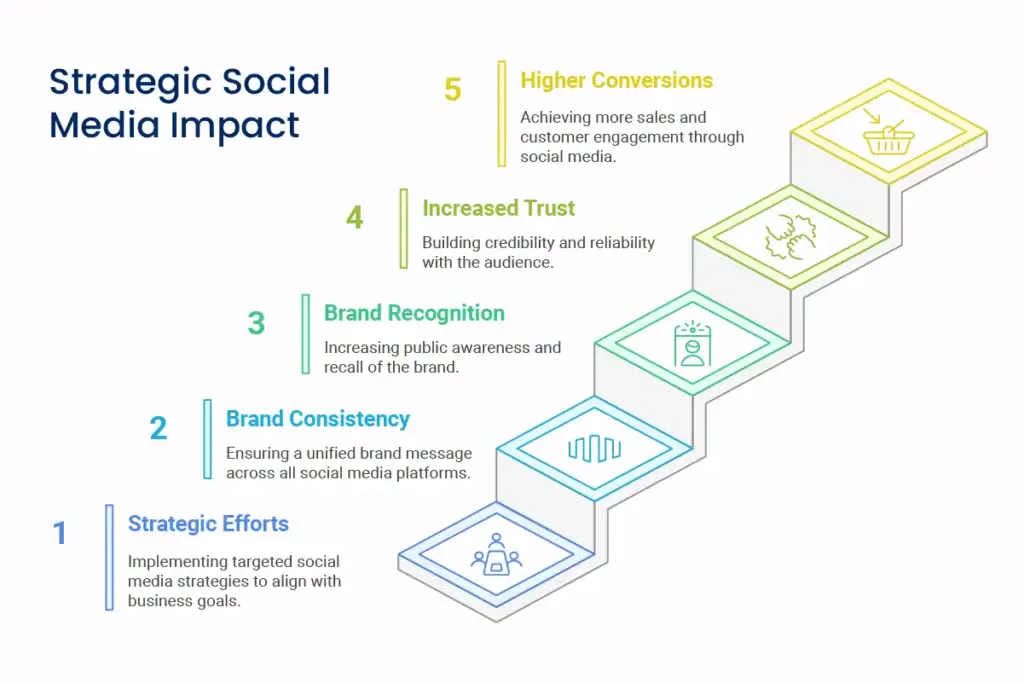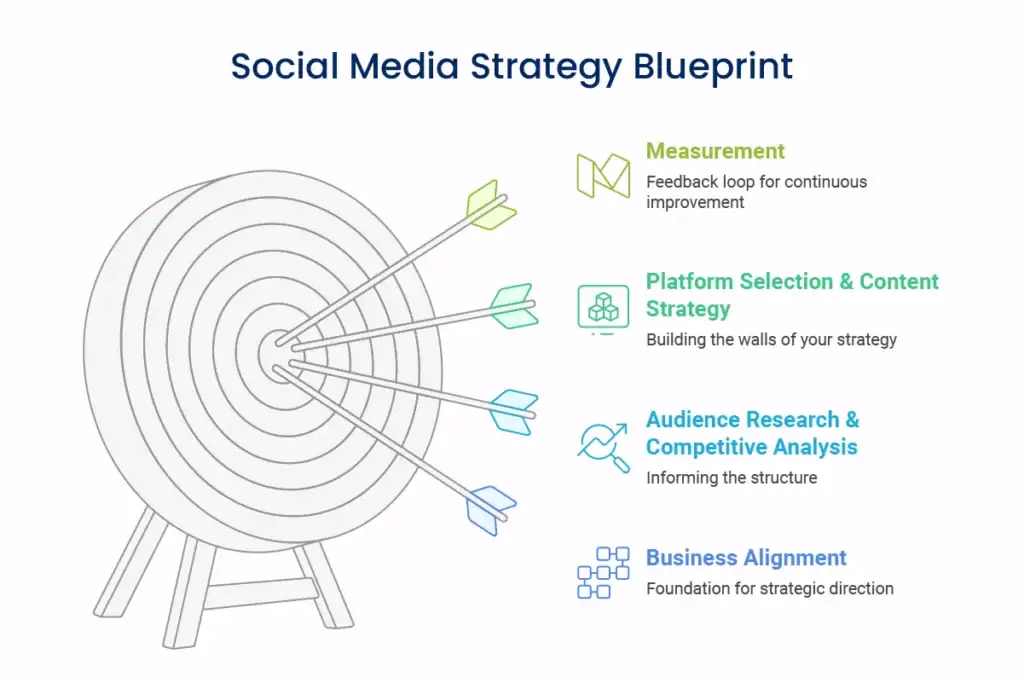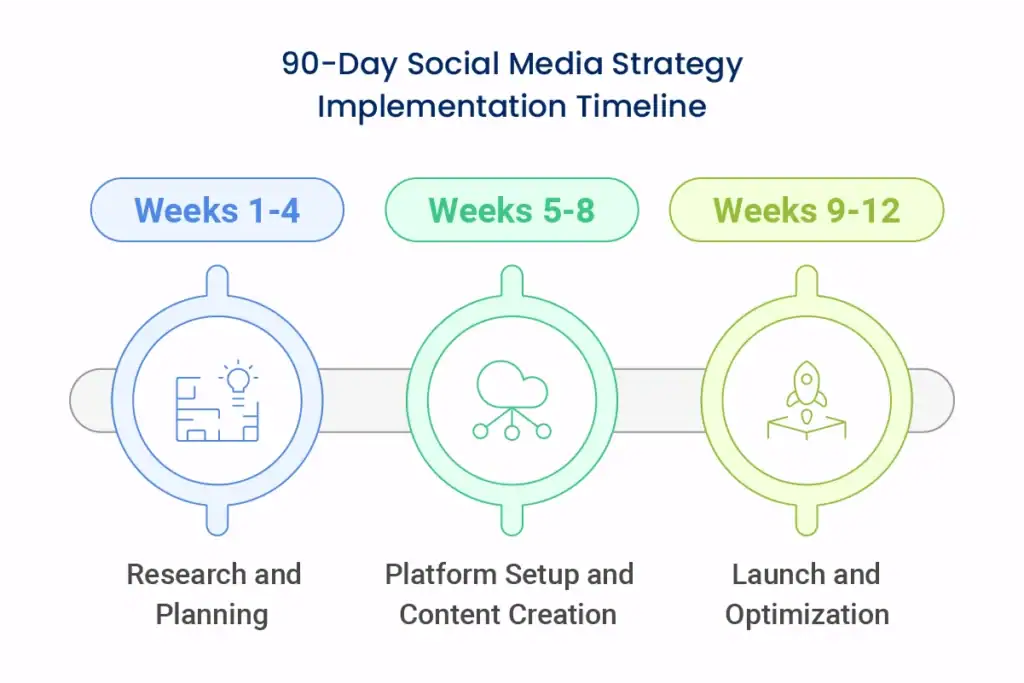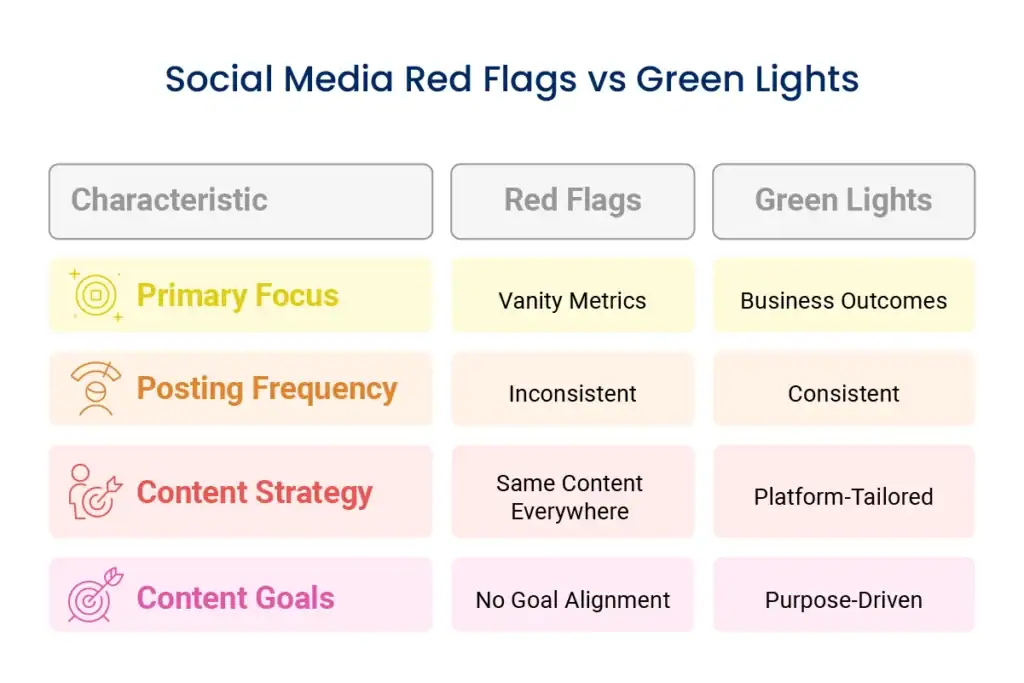Our Core Services
Social Media Strategy Development: Complete Framework for Measurable Business Impact
Your social media strategy seems disjointed, doesn’t it? You’re posting content on several platforms, interacting with fans, and managing campaigns, but you can’t quite see how any of this maps onto real business outcomes. You’re not alone—most companies plunge into social media without a map, anticipating that regular posting will somehow drive growth.
The truth is that social media success takes more than the periodic posting of content. It takes a strategy that ties each post, campaign, and interaction back to your overall business goals. Lacking that, you’re essentially dumping content into the void and hoping something sticks.
This page will take you through creating an in-depth social media strategy that turns your digital presence into a quantifiable revenue stream. We will discuss everything from audience analysis and platform choice to measurement frameworks and optimization processes that guarantee your social efforts add directly to your bottom line.

Table of Content
What is Social Media Strategy?
Social media strategy is an overall strategy that outlines how your company will leverage social channels to accomplish particular marketing and business goals. It is your guide for making a real impact with your audience while generating quantifiable results such as brand awareness, lead generation, customer acquisition, and revenue growth.
Unlike firing off random posts or riding the current trends, true social media strategy consists of intentional decisions regarding which platforms to engage on, what content to share, when to share it, and how to track success. It’s shouting into the void versus having targeted discussions with individuals who are actually interested in what you provide.
Your social media strategy becomes the tie between your brand voice and your audience’s needs. It makes every content count, from educating potential consumers to establishing trust with existing ones or driving traffic to your site. When executed correctly, it becomes a seamless experience that further reinforces your brand value while moving individuals closer to making a buying decision.

Why Social Media Strategy Matters for Your Brand or Business
Having an organized process for social media isn’t solely about appearing professional on the web—it’s about developing a framework that drives genuine business value. Here is how strategic social media management makes that much of a difference:

Brand Consistency and Recognition
Having a clear strategy allows your brand voice, visual identity, and messaging to stay in line across all platforms. This keeps customers in a state of recognition and trust, making it simple for them to find and recall your business when they're ready to make a purchase.
Targeted Audience Engagement
Strategic planning allows you to really know who you're trying to talk to and what kind of content they respond to. Targeted engagement results in increased engagement rates, improved community building, and better-qualified leads flowing into your sales funnel.
Cost-Effective Marketing
With an effective strategy, you do not spend time and money on channels or content types that do not support your business objectives. You can make your resources more valuable by investing in what offers the best return on investment.
Competitive Advantage
Most companies address social media in an ad-hoc manner. A well-designed strategy allows you to be different by offering value that your competitors are not providing, making you the go-to solution in your market.
Measurable Business Impact
Strategic social media puts in place transparent channels from social activity to business results. You can monitor how social activity drives website visits, lead generation, sales, and customer retention, demonstrating the value delivered.
Crisis Management and Reputation Protection
A strategy incorporates procedures for managing negative comments or crisis situations, safeguarding your brand reputation and customer trust even if everything fails.
Key Components of Effective Social Media Strategy Development
Business Alignment and Goal Setting
Your social media strategy needs to begin with a well-defined picture of your overall company goals. This sets the stage for all social activities to support larger company goals as opposed to standing alone.
Start by determining your top business goals for the next 12 months. These may be building brand awareness, generating qualified leads, driving website traffic, enhancing sales, or enhancing customer retention. Once you have created these objectives, break them down into explicit social media goals that align with each of them.
For instance, if your business objective is to generate 30% more leads, your social media goal could be to get 500 qualified leads to your landing pages per month via social media. This linking between business results and social activities helps make it easier to vindicate your social media investment and gauge success.

Audience Research and Persona Development
Know your audience extends well beyond core demographics. Good audience research uncovers motivations, barriers, interests, and behaviors behind your target customers’ social media strategy.
Begin by examining your current customer base to determine common traits, issues, and communication styles. Consider which social sites they most commonly use, what kinds of content they interact with, and during what times of day they are most active online.
Build rich buyer personas that not only contain demographic data, but also psychographic information such as values, interests, and social behaviors. These personas inform your content development, platform, and engagement tactics so you’re communicating directly with the most likely-to-buy individuals.
Competitive Analysis and Differentiation Strategy
Your competitive analysis allows you to differentiate your brand while studying the successes and failures of others. This research allows you to spot gaps in the marketplace and create distinctive positioning that differentiates you.
Take a look at what your immediate competitors are posting on social media, noting their themes of content, frequency of posts, engagement levels, and growth of their communities. Scan for trends in what sparks the most activity and take note of where they’re falling short and aren’t providing value to their audience.
Use these insights to craft your differentiation strategy. Your competitors might be emphasizing product features over customer education, or perhaps they’re very active on LinkedIn but not on Instagram. These opportunities are where your brand can deliver distinct value and own underserved audience segments.
Platform Selection and Channel Strategy
Not all social media platforms will work for your business. Strategic platform selection concentrates your efforts on the channels where your target audience is most engaged and active, as opposed to attempting to be present everywhere.
Assess each platform according to your audience demographics, content format preferences, and company goals. B2B businesses may be more successful on LinkedIn and Twitter, whereas visual businesses reaching younger audiences may focus on Instagram and TikTok.
Consider your content creation capabilities when selecting platforms. Video-heavy platforms like YouTube and TikTok require different resources than text-based platforms like Twitter or LinkedIn. Choose platforms where you can consistently create high-quality content that serves your audience’s needs.
Content Strategy and Editorial Planning
Your content strategy outlines what you will publish, when you will publish it, and how that piece of content contributes to your overall goals. That planning means your content calendar works for your business goals instead of simply filling posting schedules.
Create content pillars based on your audience’s interests and your area of business expertise. These could be educational content, behind-the-scenes information, customer testimonials, industry news opinion, and promotional content. An 80/20 guideline is a good rule to follow—80% valuable, non-promotional content, and 20% overt promotion.
Develop a social media content calendar that aligns content with defined business goals and audience requirements. Schedule content against significant business events, trending industries, seasonal themes, and stages in the customer journey. This planning for the future strategy allows your content to assist your goals while being relevant and timely.
Unlock Your Brand’s Potential—Start Building Your Social Media Strategy Now!
Step-by-Step Guide to Developing Your Social Media Strategy

Step 1: Business Goal Alignment Audit
Begin by recording your top business goals and determining how social media can drive each. Sit down with key stakeholders and discuss revenue projections, growth targets, and marketing priorities. Having this groundwork in place means your social program will meet real business needs instead of vanity metrics.
Step 2: Research and Define Your Target Audience
Collect information about your target audience through surveys, interviews, review of analytics, and social listening. Develop detailed buyer personas that encompass social media behavior, content preference, platform usage, and online shopping behaviors. This research informs all future decisions regarding content and platform strategy.
Step 3: Analyse Competitor Social Media Presence
Identify your top 5-8 competitors and analyze their social media activities in detail. Take note of their platform presence, content themes, posti ng frequency, engagement rates, and audience growth. Find gaps where they’re falling short in serving their audience—these are opportunities for your brand.
Step 4: Select Optimal Platform Mix
Based on your business objectives and audience research, select 2-4 platforms where you can produce high-quality, consistent content. Take into account platform demographics, the requirements for content formats, and your resources. It’s more effective to be great on a few platforms than to be average across many.
Step 5: Develop Content Strategy Framework
Build content pillars that reflect your audience’s interests and your business expertise. Outline your content mix to feature educational content, entertainment, community building, and promotional content. Create brand voice guidelines to ensure consistency across all platforms and team members.
Step 6: Social Media Content Calendar System
Establish a planning system where you can post weeks or months ahead but are also flexible to post real-time opportunities. Make sure to add key business dates, industry happenings, and seasonal themes. Map out content to support various phases of the customer journey, from awareness, through purchase, to retention.
Step 7: Establish Measurement Framework
Identify key performance indicators that link social media efforts to business performance. These could be website traffic via social, lead generation, conversion rate, customer acquisition cost, and lifetime value. Implement tracking systems that enable you to measure these metrics consistently and accurately.
Step 8: Implement Community Management Protocols
Develop comment, message, and mention response guidelines that capture your brand voice in a manner that offers top-notch customer service. Set response time goals and escalation processes for various interaction types. Train staff to ensure brand voice and customer service consistency.
Recommended Tools and Methods
Choosing the appropriate tools will make or break your custom website design project:

Content Planning and Scheduling Tools
Hootsuite and Buffer provide end-to-end social media management features that automate content planning, scheduling, and rudimentary analytics. They enable you to schedule regular posts while saving time for interaction and strategy formulation.
Analytics and Measurement Platforms
Google Analytics offers in-depth information about social media strategy converting on your website, whereas native platform analytics such as Instagram Insights and LinkedIn Analytics provide platform-specific engagement metrics. Use these tools together to get the full picture for both social performance and business impact.
Content Creation Tools
Canva streamlines visual content development with templates for various social platforms, and software such as Loom facilitates easy creation of learning video content. These tools ensure visual uniformity at the cost of lower content development time and expenses.
Social Monitoring and Listening Tools
Mention and Brand24 enable you to track discussions regarding your brand, industry trends, and competitors on social platforms. Such intelligence is used to drive content strategy while enabling you to find opportunities for community building and engagement.
Common Mistakes to Avoid in Custom Website Design

Focusing on Vanity Metrics Over Business Impact
Too many businesses are enamored with follower numbers and likes without paying attention to metrics that really count towards business growth. Prioritize the quality of engagement, website traffic, lead generation, and conversion rates instead of reach and impressions.
Inconsistent Brand Voice Across Platforms
Different platforms might demand different content formats, but your brand voice needs to be the same. Create distinct voice guidelines that are effective on all platforms while modifying your content style to suit every platform’s culture and expectations.
Neglecting Community Management
Posting content without responding to your audience overlooks the “social” in social media. Answer comments, join the conversation, and form relationships with your community. This interaction frequently creates more business value than the content posted.
Trying to Be Present on Every Platform
Scattering yourself too thinly across numerous platforms usually leads to mediocre performance across the board. Strategically select platforms depending on your audience and resources, then perform at an exceptionally high level on the selected channels.
Boost Your Brand’s Engagement—Let’s Design a Winning Social Media Strategy!
Conclusion
Developing a successful social media strategy needs patience, consistency, and a willingness to change based on evidence and audience reaction. The structure we’ve mapped out here is a good starting point for developing social media presence that generates actual business outcomes rather than mere online engagement.
Keep in mind that social media management is only a part of a larger digital marketing strategy that should harmonize with your other marketing activity. When your social strategy is aligned with your overall marketing strategy for branding, you build a cohesive experience that generates trust and converts more effectively.
The secret to long-term success is to see social media as a relationship-building platform instead of a broadcasting tool. Think of delivering authentic value to your audience, and the business outcomes will naturally follow. Your content marketing strategies must complement this relationship-building by providing insights, solutions, and experiences that improve the lives of your audience on a consistent basis.
Social media strategy building is a continuous task that necessitates constant revision and optimization. As platforms change and your business expands, your strategy should change along with them. The time you invest in establishing this foundation will pay dividends as your social presence becomes a reliable driver of business growth and customer loyalty.
Need Help with Social Media Strategy Development?
Creating a solid social media strategy can be daunting, even when you’re running your entire business yourself. If you want to assist in creating a strategic plan that serves your business objective and delivers quantifiable outcomes, you may wish to have the help of seasoned experts familiar with both social media best practices and business development goals.
A thoughtfully executed social media strategy becomes one of your richest digital branding assets, building enduring relationships with your audience and fueling healthy business growth.
